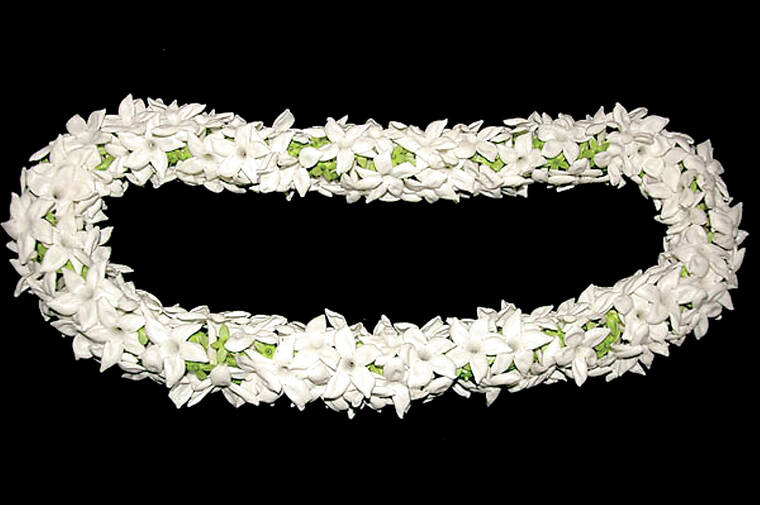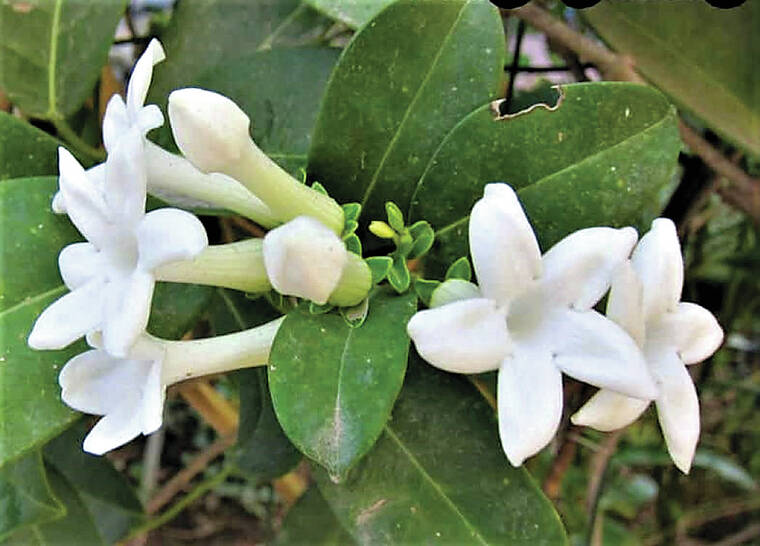I like to recommend lovely fragrant plants that seem to grow well here in Hawaii whenever I come across them. My stephanotis vine has been thriving and flowering for months now. This plant with tough dark green leaves and clusters of white flowers can climb a fence, trellis or garden wall and waft a sweet fragrance into the air wherever it is placed. When well located, it will produce numerous clusters of fragrant blossoms from early spring into late summer.
Formerly known as Stephanotis floribunda, the new botanical name is Marsdenia floribunda. ‘Stephanotis’ was added to the Marsdenia genus by botanists in 1990 but the older name is still commonly used. The earlier genus name derives from the Greek stephanos, or crown, and otis for ear, referring to the arrangement of the stamens in the flower which are supposedly ear-shaped. The species name refers to the abundant flowers the plant produces.
The Marsdenia genus, which includes about 125 species, honors the English author who wrote the “History of Sumatra” in 1783. Plants in the Marsdenia genus are in the Asclepiadaceae, or milkweed, family. The family includes some other plants that grow well here including crown flower, hoya and pakalana. Stephanotis shares the characteristic of milky sap with these other members of the family.
Stephanotis is native to Madagascar, an island country located off the southeastern coast of Africa in the Indian Ocean. This somewhat isolated island, like Hawaii, is home to thousands of native plant species. Ninety percent of Madagascar’s native plants are endemic, which means their genetic match is found nowhere else. Many of these native species have become popular throughout the world.
Stephanotis is sometimes called by the common name Madagascar jasmine, referring to its origin. Since its discovery, however, its cultivation has spread to many areas with tropical climates as well as to greenhouse cultivation in temperate zones. Stephanotis was introduced into European horticulture in 1839. By the 1870s it made it to Hawaii where it was named pua male (wedding flower).
Though they are grown for their strongly perfumed flowers, stephanotis plants have many other features to recommend it to gardeners. It is a perfect plant for covering a fence or trellis. Though it may grow slowly at first, once established it will send out lots of twining stems up to 30 feet long to cover its support structure. The stems support leathery, dark green, oval leaves along with clusters of white flowers that have a waxy appearance. With some guidance, the vine will follow its support structure both horizontally and vertically.
Stephanotis flowers are trumpet-shaped with five petals arranged in a star pattern. They measure one to two inches across. The flowers are long lasting once cut and don’t bruise easily, making them great for lei making or for a bouquet. Following heavy blooming periods, large seed pods may appear. They are thick-skinned, green, oval-shaped fruit about five inches long. The pods take about six months to fully ripen. When ripe, they turn brown and open to reveal hundreds of flat brown seeds attached to feathery wisps that help them disperse in the wind.
Stephanotis qualifies as a xeriscape plant meaning it can grow well in sunny, hot and dry conditions with little care. It is moderately drought and salt tolerant. Increased flower production can be achieved by enhancing the soil with organic matter and adding ample water. Good soil drainage is very important. Fertilizing quarterly seems to assure vigorous growth and profuse flowering.
Little maintenance is needed beyond training and pruning the woody vine for growth control. Of course, over-fertilizing and the rapid growth it creates can make the plants more attractive to pests, though the milky sap is somewhat of a deterrent. Some sucking insects, including mealy bugs and scale, may appear but can usually be controlled with a low toxic soap and oil mixture or mild insecticidal sprays.
Stephanotis is not hard to propagate. Cuttings from green shoots, dipped in rooting hormone and set in a combination of vermiculite and perlite will usually root within a month’s time. Sexual reproduction from seeds can be equally successful and provides a better root structure for the plant. Though seed pods appear rarely, once they do appear, make plans to use the numerous seeds to produce new plants. The pod will turn yellow as it starts to ripen. You can remove it then to allow it to ripen fully off the vine. If you leave it on the vine until it is brown and fully ripe, it may open and release the seeds to the wind.
Plant the fresh seeds in containers near the surface of the potting mix and keep the soil slightly moist. Germination can take from two weeks to two months. Putting the container into a plastic bag can help keep the medium moist and may speed germination, but air it out regularly to prevent molding.
After determining that the seedlings have established a healthy root system, they can be carefully moved to their desired location. Choose a location where the roots can be consistently cool while the vine is in full sun. Care should be taken when transplanting as stephanotis roots are brittle and break easily. Stephanotis can also be grown as a house plant in a sunny window.
Most local nurseries and plant departments carry stephanotis vines, but call first to see if they have them in stock.
Gardening Events
Saturdays:
• “Work Day at Amy Greenwell Garden” from 9 a.m. to 12:30 p.m. Meet at the Garden Visitor Center across from the Manago Hotel in Captain Cook. Come with a mask and prepared to practice social distancing. Volunteers can help with garden maintenance and are invited to bring a brown bag lunch. Water and snacks provided. Visit the website www.amygreenwell.garden/get-involved/volunteer-1/ and sign up for the weekly email for more information on work days.
Save the dates:
• October 5-7: “33rd Annual Hawaii Tropical Fruit Growers Conference” starting at 8 a.m. on Oct. 5 going to 2 p.m. on Oct. 7 at Blaisdell Center in Honolulu. Topic: “Security Starts with the Soil”. More information at https://www.htfg.org/event-details/33rd-annual-htfg-conference-1 • October 17-18: “Malama the Farmer” at the Grand Naniloa Hotel in Hilo. Oct. 17 breakout sessions, Oct. 18 agricultural businesses tour. Registration $225 for both days. Sponsorships available for farmers. Sponsored by UH CTAHR and Western Region Agricultural Stress Assistance Program. More information at AgrabilityTraining and Events or contact Agrability Partners Tess McKeel at tmckeel@goodwillfingerlakes.org or JoBeth Rath at jbrath@goodwillfingerlakes.org.
Farmer Direct Markets
(Check websites for the latest hours and online markets)
Wednesday:
• “Ho‘oulu Farmers Market” 9 a.m. to 2 p.m. at Sheraton Kona Resort &Spa at Keauhou Bay
Saturday:
• “Keauhou Farmers Market” 8 a.m. to noon at Keauhou Shopping Center. Information on their online market: keauhoufarmersmarket.com/onlinemarket
• “Kamuela Farmer’s Market” 7:30 a.m. to noon at Pukalani Stables
• “Waimea Town Market” 7:30 a.m. to noon at the Parker School in central Waimea
• “Waimea Homestead Farmers Market” from 7:30 a.m. to noon at the Waimea middle and elementary school playground
Sunday:
• “Pure Kona Green Market” 9 a.m. to 2 p.m. at Amy Greenwell Garden in Captain Cook
• “Hamakua Harvest” 9 a.m. to 2 p.m. at Hwy 19 and Mamane Street in Honokaa
Plant Advice Lines
Anytime: konamg@hawaii.edu
Tuesdays &Thursdays: 9 a.m. to noon at UH-CES in Kainaliu — 322-4893 or walk in
Mon., Tues. &Fri: 9 a.m. to noon at UH CES at Komohana in Hilo — 981-5199 or himga@hawaii.edu
Diana Duff is a plant adviser, educator and consultant living part time in Kailua-Kona.


